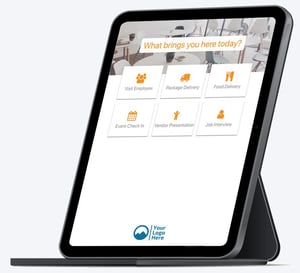How to Maximize the Productivity of Your Super Receptionist | Greetly
Many receptionists double as company superhero. Use these tips to maximize the productivity of your receptionist and to help them succeed.
Most workplaces have moved away from dedicated receptionists and COVID-19 will further this trend. Here are tips for a great reception-less reception.
Does your office really need a receptionist? Over the last decade, many companies questioned the necessity of having a dedicated person sitting at a desk simply to greet guests. In some workplaces, the reception area went empty; in others, an employee from another function wound up in a dual role.
Today there is another consideration: How COVID-19 will impact workplace reception areas. Organizations have to plan for lower staffing levels at any point in time, or visitors who do not want any unnecessary human-to-human interactions.
So, what does it really take to be a place without a receptionist?

Reception expectations have changed drastically over the years. Dedicated receptionists used to be the norm in most offices. Some organizations have few visitors, some have many, but nearly every organization has a number of tasks that need to get done and can’t really afford to have someone sitting idly in between greeting and assisting guests.
Studies show that interruptions – such as answering the phone, greeting a guest, or assisting a delivery person – have tremendous costs in the workplace.
Over the years, many organizations have tried to do away with the receptionist.
In our technologically savvy world of today, some organizations are recognizing that technology is better suited to handle repetitive work than people are. They are often adding digital visitor management systems to their lobbies and using other technology solutions.
At the same time, many companies are loathed to eliminate the receptionist altogether. To understand why, it is important to explore the different reception strategies available, and the pros and cons of each.

Human receptionists come in three major categories: dedicated receptionists, semi-dedicated receptionists, and informal receptionists.
A dedicated receptionist is a person whose sole job is to be the face of the organization to greet and assist visitors. Primary duties include:
Dedicated receptionists are few and far between these days. Most organizations recognize that, unless they have a tremendous number of visitors, it is just not cost-effective to have someone doing nothing in between the act of assisting guests. Hospitality sector services, like hotels, restaurants, and museums, might find that staffing a guest information desk is a good use of their resources.
Most office buildings, manufacturers, and other organizations, however, are more apt to use the semi-dedicated or informal receptionist.
A semi-dedicated receptionist is a person with all the duties outlined above who also has additional responsibilities they work on between guests. This person is often an administrative assistant or an office manager. Responsibilities can vary widely. A semi-dedicated receptionist can do tasks like:
The list could really go on forever. The one thing a semi-dedicated receptionist might be discouraged from doing is leaving the desk unattended for more than scheduled breaks.
The benefit of a semi-dedicated receptionist is clear: having a human being who gets other necessary work done between guests makes the receptionist position less of a drag on monetary resources.
The opposite end of the spectrum is the informal receptionist. This is the poor soul who has a functional job to do but happens to sit at a desk near the main door. Those organizations who have done away with dedicated or semi-dedicated receptionists as a cost-saving measure may have inadvertently assigned the role to someone who never applied for it. Guests who don’t know what they’re doing or where they’re going will default to asking the first person they find.
This person may find their work constantly interrupted. Not only will their productivity suffer but it is also likely their job satisfaction will be low.
The benefits of having a human receptionist are primarily in the field of guest relations. A human receptionist:
The drawbacks of human receptionists lay mostly in terms of cost and efficiency.

In many areas of our daily lives, technology is replacing people. We have automatic car washes and email, dishwashers, and self-checkout. Booking a vacation used to be an incredibly time-consuming process, so people used travel agents. While agents still have their place, many people have taken to using online resources to take control of travel plans themselves. In the same way, new technologies are popping up all the time in the field of office services and reception.
Like with human receptionists, there are a variety of possibilities for technological reception.
The first is what we’re calling gateway receptionists. These are technologies that block access to an area until a host has been reached. Think of the buzzer in the lobby or outside the door of an apartment building. Using these crude systems, the visitor looks at the directory, finds their host’s name, presses a button, and the host is contacted. Either the host unlocks the door remotely for the guest or comes to retrieve their guest. Some offices use similar technology, either with intercoms or a telephone.
While this technology is incredibly cost-effective and generally inexpensive, there are drawbacks.
Digital receptionists, sometimes known as digital visitor management systems, are fast becoming a viable option for more offices. These are visitor sign-in apps loaded onto laptops, tablets, or kiosks that allow visitors to check in themselves. We’re seeing them more at airports, hotels, doctors’ offices, and other offices of any kind.
Depending on the system selected, these systems can perform a number of valuable tasks:
Virtual receptionists and automated answering services are some other options organizations are employing. Unlike the previous two methods, these methods are more about answering phone calls and email requests for information than it is about greeting visitors at the door.
It is likely we’ve all experienced automated answering services: “To speak to John H., please press 1. To report a problem with your service, please press 2.” They are efficient ways to route calls – assuming the request fits in the framework – and cost less than hiring a person. Some companies are even using artificial intelligence to answer customer service questions.
Unlike automated answering, virtual receptionists are living, breathing human beings who answer telephones, route calls, answer basic questions, and schedule appointments. The major difference is they are not onsite. That difference has great benefits for the company’s bottom line. Because virtual receptionists are not onsite and only work when they get a call, they cost a fraction of what an in-person receptionist costs. They learn about the company before answering calls and are dedicated to giving callers a professional experience.
The pros and cons of technology are tricky and largely depend on the technology chosen. Benefits generally include:
Disadvantages of technology include:
Here are some scenarios where it will make more sense for your workplace to use technology to greet visitors:
It should be apparent by now that most workplaces have adopted a solution very different than the dedicated receptionist of the past. While some have simply ignored the visitor experience, others have gained efficiency using modern visitor management solutions.
Consider the technological possibilities. They are not all one-and-done. It is always an option to use multiple technologies to complete the best job for your company.
Regardless of what approach you choose for your workplace, it is likely technology can help your office function more smoothly.
Many receptionists double as company superhero. Use these tips to maximize the productivity of your receptionist and to help them succeed.
Using a virtual receptionist service with a digital reception app automates your reception function and frees up your most valuable resource: your...
Can a virtual receptionist app really help your small office increase profit? Yes it can! Hire Greetly and save $37,076 per year versus a live...